We loaded our belongings into the car, making sure that we had our coats since it was a bit chilly, and set out on the cottage lane to the N-52.
The traffic was trivial, even when we turned South onto the R-162 to Navan. From Navan, we drove on the N-3 to Dublin. The traffic began picking up as we neared the city. What we had not reckoned is that it was a Monday morning, and we ended up getting tangled up in not only commute traffic, but also road work, which left us creeping along at a snail’s pace, adding more than an hour to our travel time. You live and learn, and in this, we learned to avoid the M-50 unless it was absolutely necessary to our journey, which, of course, it would be part of our drive back later in the day.
From the M-50, we took exit 11 to the N-81. We drove along this beautiful stretch of highway until we came to the small village of Hollywood where we caught the R-756 to the Wicklow Mountains, where the ancient monastic site of Glendalough lay. The road was actually closed to through traffic, but when we asked one of the workers, he told us to, “drive up this road, make a right, then make another right at the old church graveyard. That'll get you back on the R-756”. We took his directions, and sure enough, were back on the road in no time.
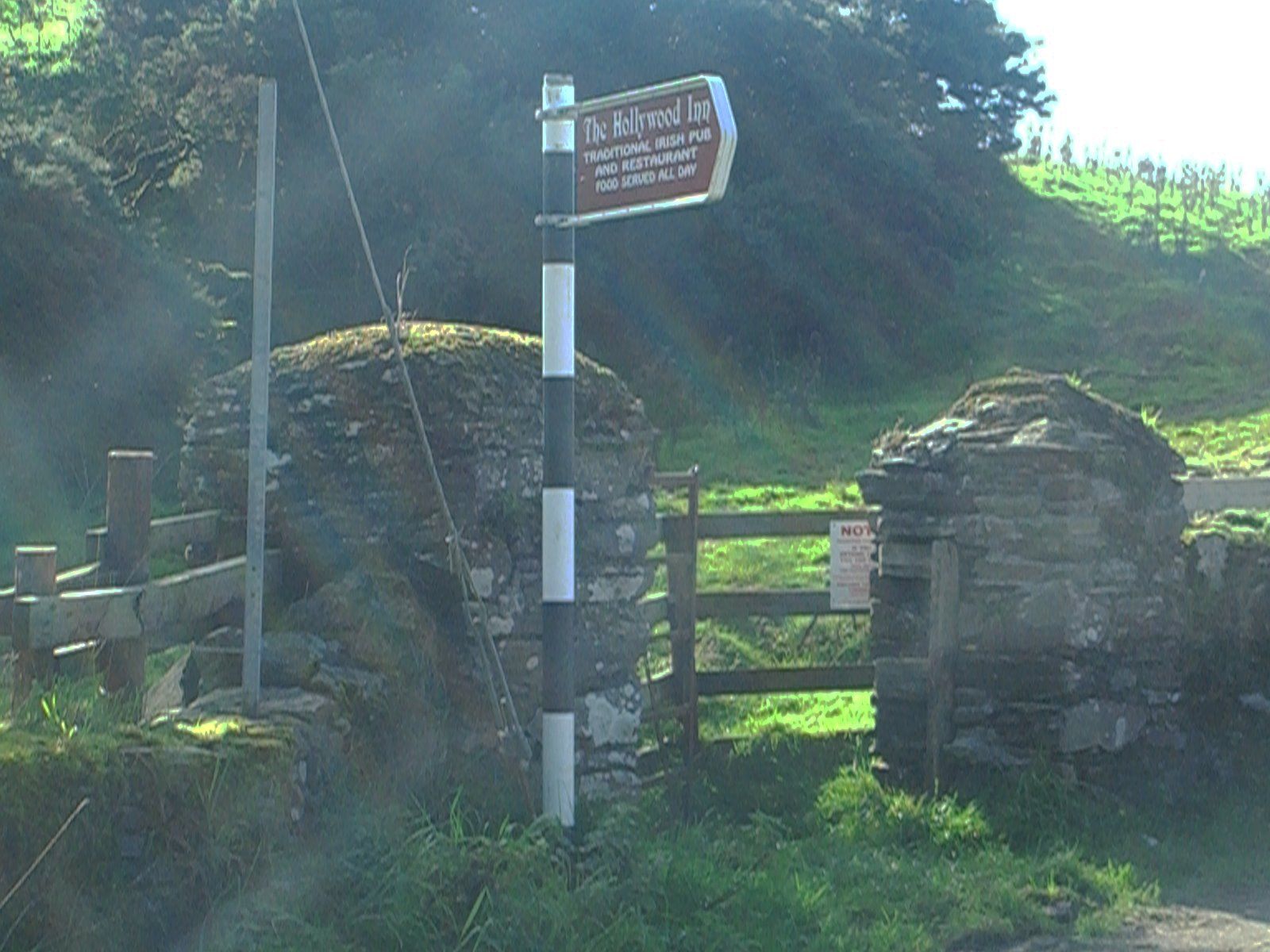
Hollywood - Wicklow Mountains
It was a lovely drive, with hardly any traffic in either direction. We enjoyed the splendorous beauty that surrounded us.
Crossing the Kings River, we stopped on the bridge long enough to take a few photos and record some of the beauty on the camcorder. The view was stunning, to say the least. The blue of the sky rivaled even the rarest of sapphires, and the water of the river itself rippled quietly along. There was the usual herd of cattle in the fields on both sides of the river.
We crossed the bridge, heading west toward the Wicklow Mountains. We noticed that there were sheep and goats grazing along the sides of the road. We stopped to admire one goat in particular. He seemed friendly enough, even posing for us, but after a few minutes, he headed toward the car to give it a good butting! Tom edged the car away, careful not to hit the beautiful and wild creature.
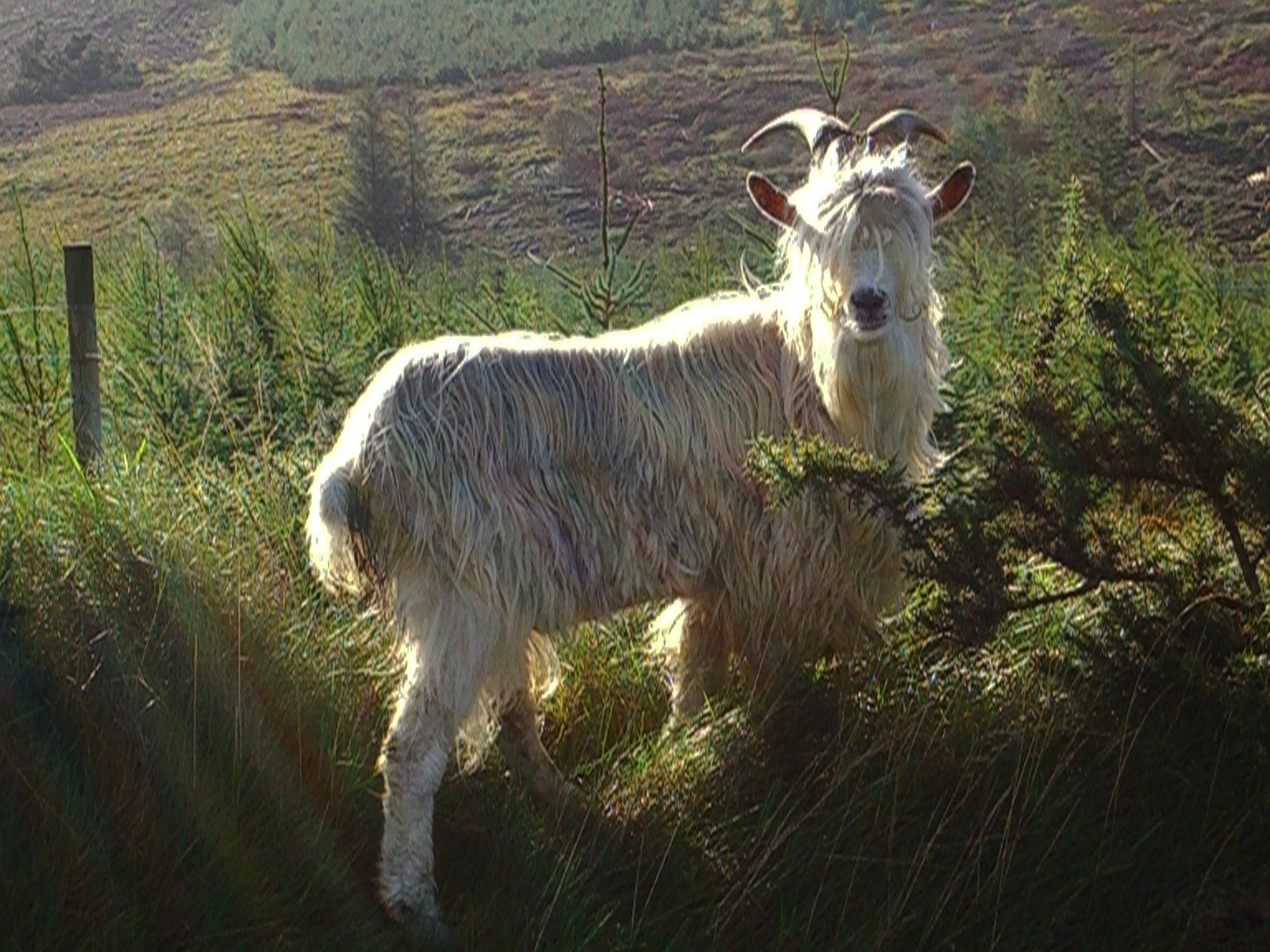
Goat On The Road To Glendalough
As we worked our way through the mountains, we noted the geography of the area. This was where the ancient Irish had come to quarry the quartz used at Newgrange, Knowth, and Loughcrew over five thousand years ago. The quartz stones were loaded onto coracles, which were little boats built out of animal skins and wood, and floated down the river to the Irish Sea. From there, the workers rowed over fifty miles to the mouth of the River Boyne in Drogheda Bay, then on another thirty miles to the burial mounds. As far as Loughcrew is concerned, those quartz stones were more than likely moved by foot through the dense forest of the ancient Irish landscape. To say that these people were dedicated and committed is without a doubt truth. However, it would be impossible for us to actually grasp the extent of their devotion to their very spiritual and important work.
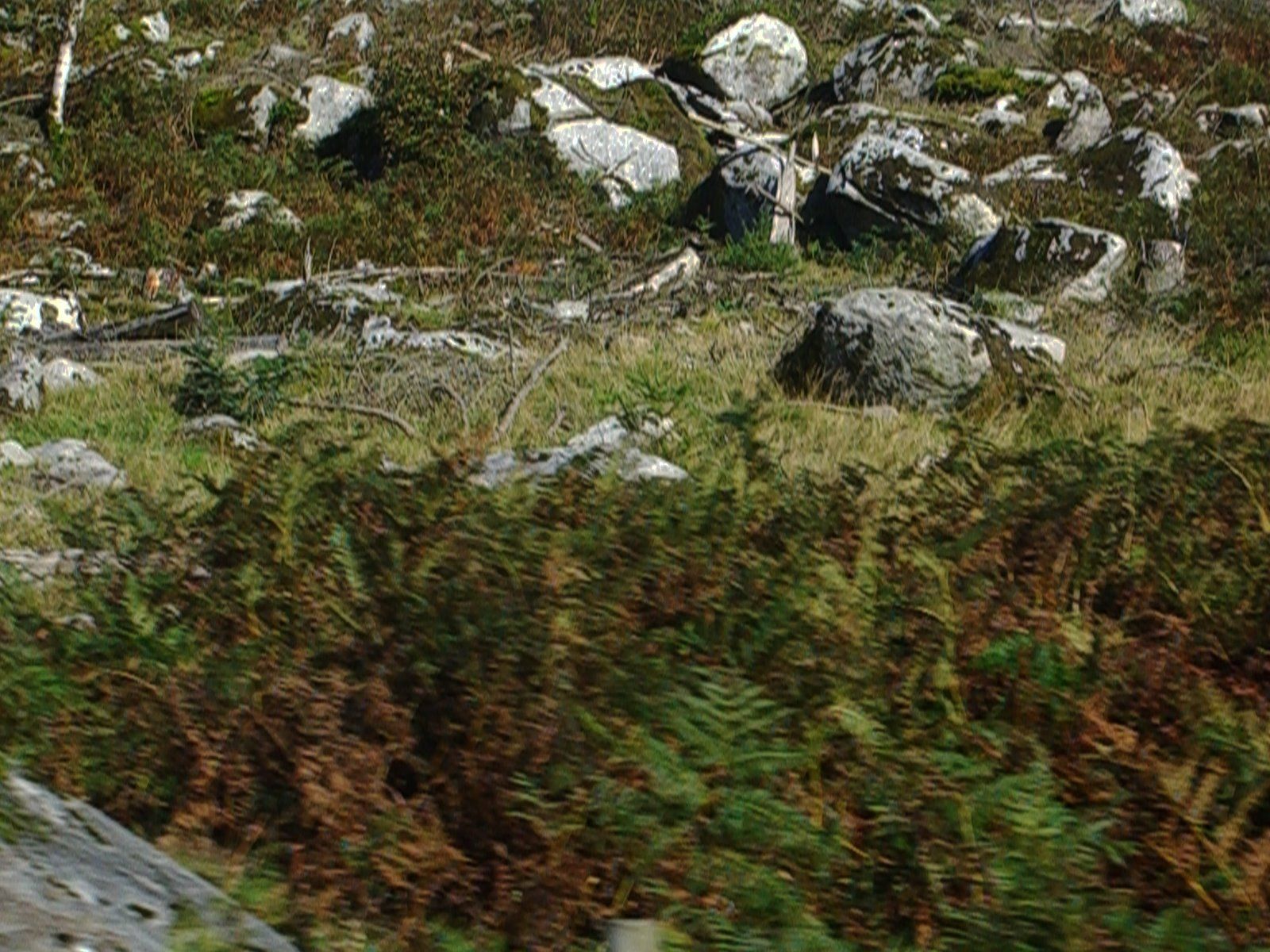
Rocks Along The Way To Glendalough
We traveled further down the road, soon finding ourselves behind an oversized truck carrying a load of wool. Since the road was quite narrow, we had no opportunity to pass it. The wind started to blow, picking up loose pieces of the wool, and hurling them into the trees along the side of the road, creating a kind of “Spanish Moss” effect. Wool had apparently been hauled down this road for years, as the canopy of trees over the road hung heavy with the substance. It was beautiful and odd, something we would never see in the States, at least not in the Bay Area where we live.
We found ourselves quite entertained by this sight, so entertained that we actually passed the turn-off to Glendalough. Tom drove about a quarter mile further before finding a place to turn around. Heading back the way we had come from gave us a better vantage point to see the sign. Tom turned right onto the road.
We were both quite excited with the opportunity to visit such a beautiful site and to see some of the history hidden deep within the mysterious Wicklow Mountains. It didn’t take long before were at the end of the road and in the car park. Tom parked the car neatly in one of the slots. Locking the car, we set out to the visitor’s center to pay our admission, which wasn't required unless we signed up for one of the tours. We love discovering things on our own as often as possible, so out the door we went, ready to find out just what brought Saint Kevin here in his solitary quest for the Spirit all those many years ago.
We crossed the bridge which spanned the River Glendasan, which is fed by the River Glenealo. We gazed beyond the river into the valley beyond. This was where Saint Kevin had come to dwell as a hermit, far away from the towns and villages in the lands beyond the mountains. He did not, however, succeed in achieving an eremite life, as his fame spread over the entire island of Ireland and beyond. Pilgrims came from far and wide, seeking his wisdom and knowledge. This monastic site far exceeded even Dublin in size during its height of popularity. The many ruins which remain today are thought to be some of the finest known to humankind.
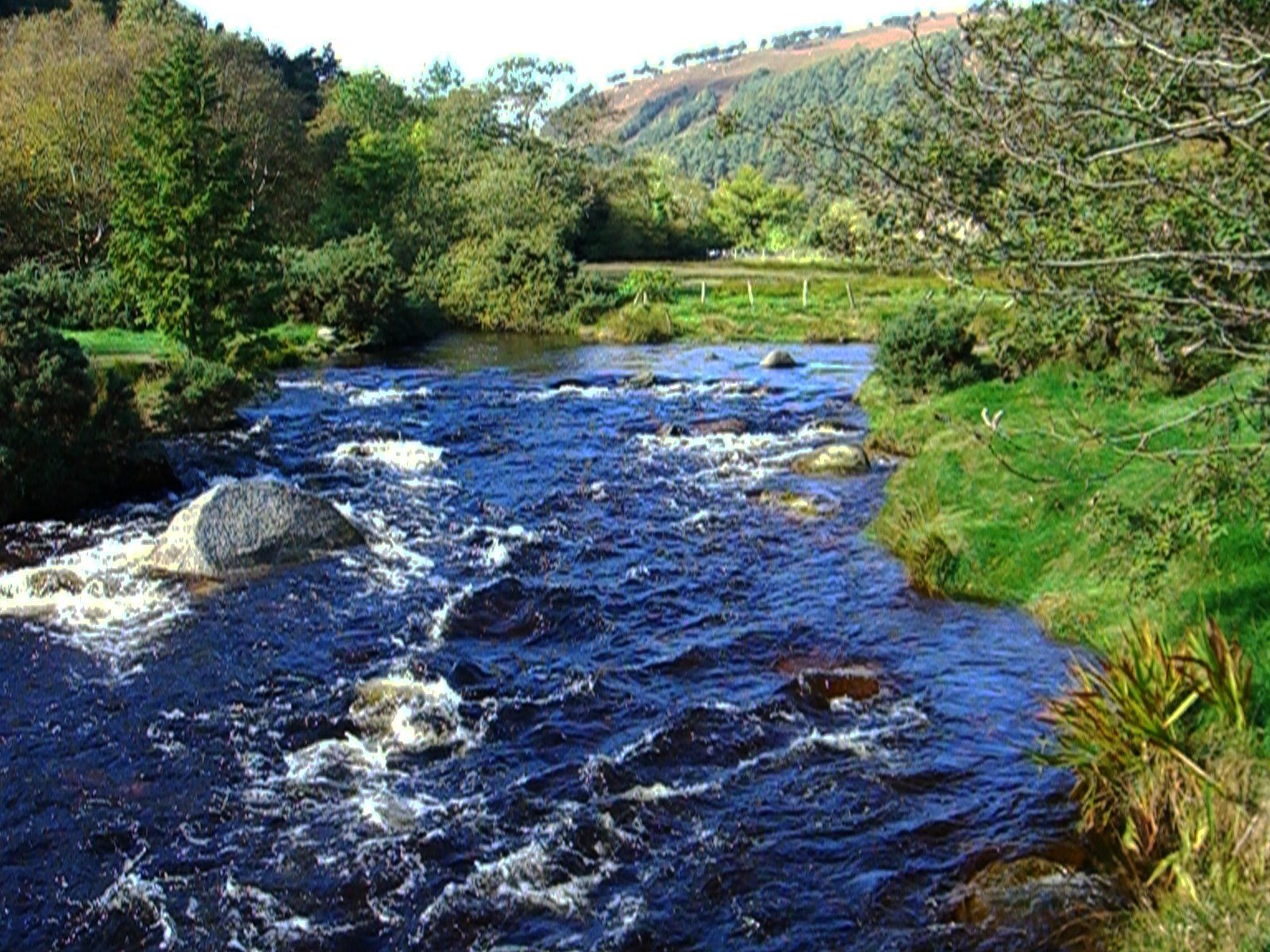
The River Glendasan - Glendalough
We stood for a while on the bridge, enjoying the sound of the melodious flow of the river. As the water rushed by, the currents formed foamy crests which moved swiftly downstream. The liquid was stunning, deep sapphire blue, like holy and sacred water rapidly traveling toward the heavens. With the blue of the sky as a startling backdrop, we could well see why Saint Kevin would find this place to be his very own heaven on earth. This would most certainly be an ideal place for solitude and devotion, where one could reach out and touch Deity moment by moment. Tom and I were honored to be here and taking the time to come to this beautiful valley of serenity was well worth it.
As I stood on the bridge I was hit by a gust of cold air. The wind coming off of the water was very fresh, and I realized I should have worn either my sweater or coat, but not wanting to walk back to the car, I decided I would be fine. Tom, the gentleman that he is, offered to go back, but I declined the offer. We moved across the bridge, ready to explore more of what this site had to offer. The sheer beauty of this valley was overwhelming, and we were excited to be able to discover the secrets and treasures of the past which were held within its land. We did not have all day here, so we started up the path toward the monastic ruins themselves.
As we walked down the tree-lined path, we noticed many herbs lining the sides. We wondered if these had been planted by the people who had lived here so many years ago. As we wandered further, we came upon an interesting alcove that appeared to have been the remains of a dwelling spot. It was a solitary and quiet place in the dark forest, a true refuge for one who sought to be alone. It is said that an angel led Saint Kevin to a cave in a remote precipice at Glendalough, where he lived as a hermit for seven years. In legend, it is said that he was led there by an angel. He wore animal skins, ate the nettles and herbs that grew in the land close by, and prayed continuously. Fame of his holiness spread throughout the land, and much to his dismay, he attracted many followers who sought to learn from him.
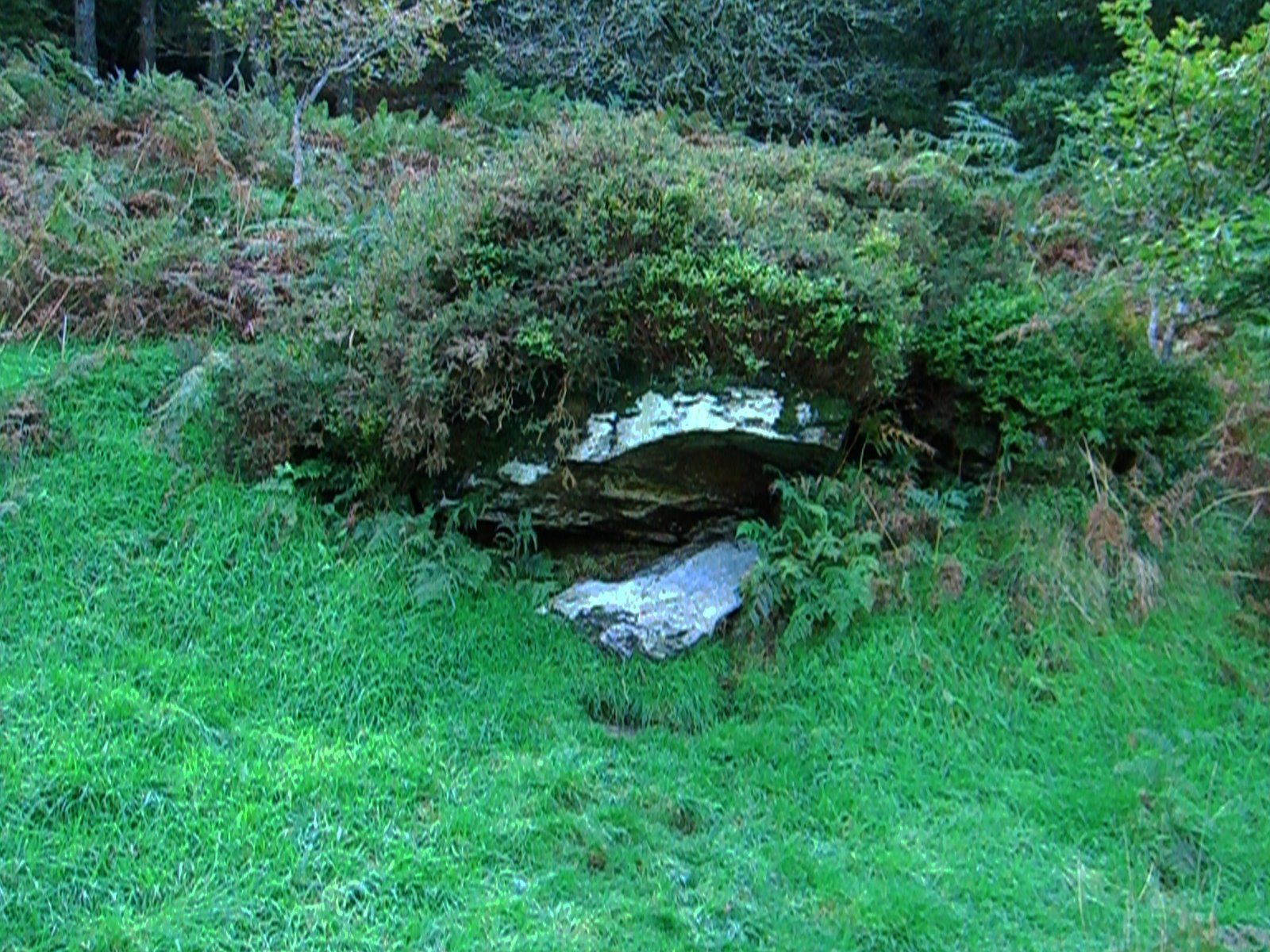
Herbs Along The Way - Glendalough
After a while, we came to another bridge, this one a bit smaller than the first. Tom crossed in front of me, and I was able to capture an image of him. The bridge took us back over the River Glendasan, into the monastic yard itself. The dampness of the river moved into the air, reaching my skin as I walked over the bridge. I was chilled, but not overly so. I had already been sniffling, which was most likely from going to bed with wet hair on Saturday night. I hoped that I would not come down with a full-blown cold. Well, we were here to discover the magic of Ireland, and capture it we would, even if it meant through a fog of sneezing and coughing!
One of the first things we saw after crossing the footbridge is a building known as Saint Kevin's Kitchen, or more properly, Saint Kevin's Church. This building is a nave-and-chancel church built in the twelfth century. There is a small round tower located above the west doorway. The roof, which is made entirely of stone, is kept from drooping in the center by the wall of a smaller room above the nave of the church. The round tower, which was added to the church after the original construction, served as a belfry. All that remains of the chancel are the foundations. The stone-roofed sacristy still stands beside it. To the right, immediately off of the bridge, are the remains of one of the many dwelling houses of the inhabitants of this magnificent and sacred site. There sits in the interior a very interestingly carved stone. It appears that the shape of a rudimentary cross had been chiseled from it.
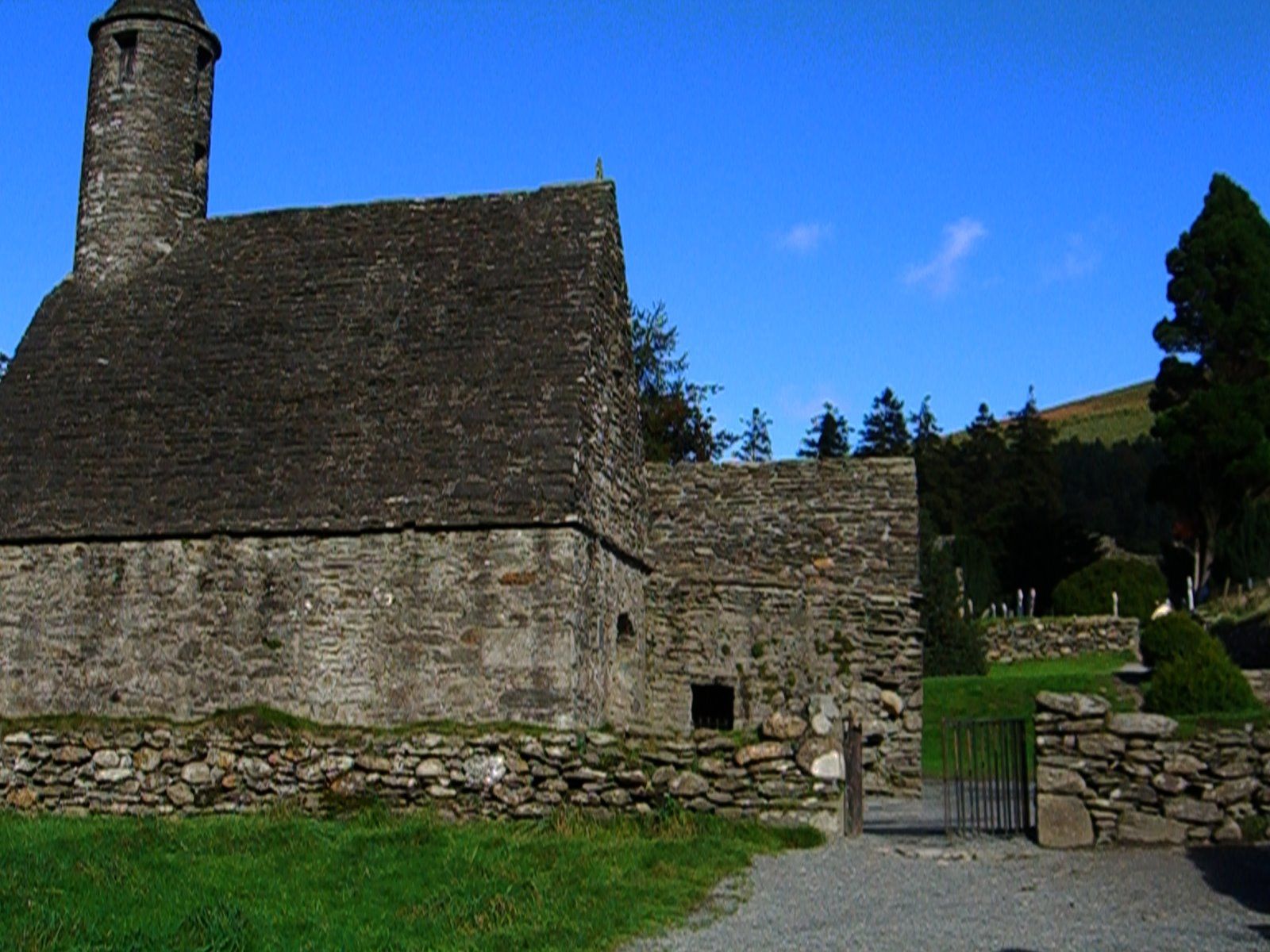
St. Kevin's Kitchen - Glendalough
As we walked deeper onto the grounds, we entered the graveyard proper. Most of the graves are centuries old, but some are as recent as October 25, 1995. The graveyard is kept in beautiful shape. I imagine that there is a daily caretaker. I know that there was a gardener in attendance during our visit, sprucing up the greenery and trimming the grass along the graves themselves. There were headstones everywhere we looked. Some were on flat ground, others on very steep slopes. I love looking at headstones, and as I worked my way up a hill, I bumped against a group of them and broke the crystal on my watch. At least I didn't cut myself. Even so, I managed to climb to where I wanted to be in order to view more dates on the headstones.
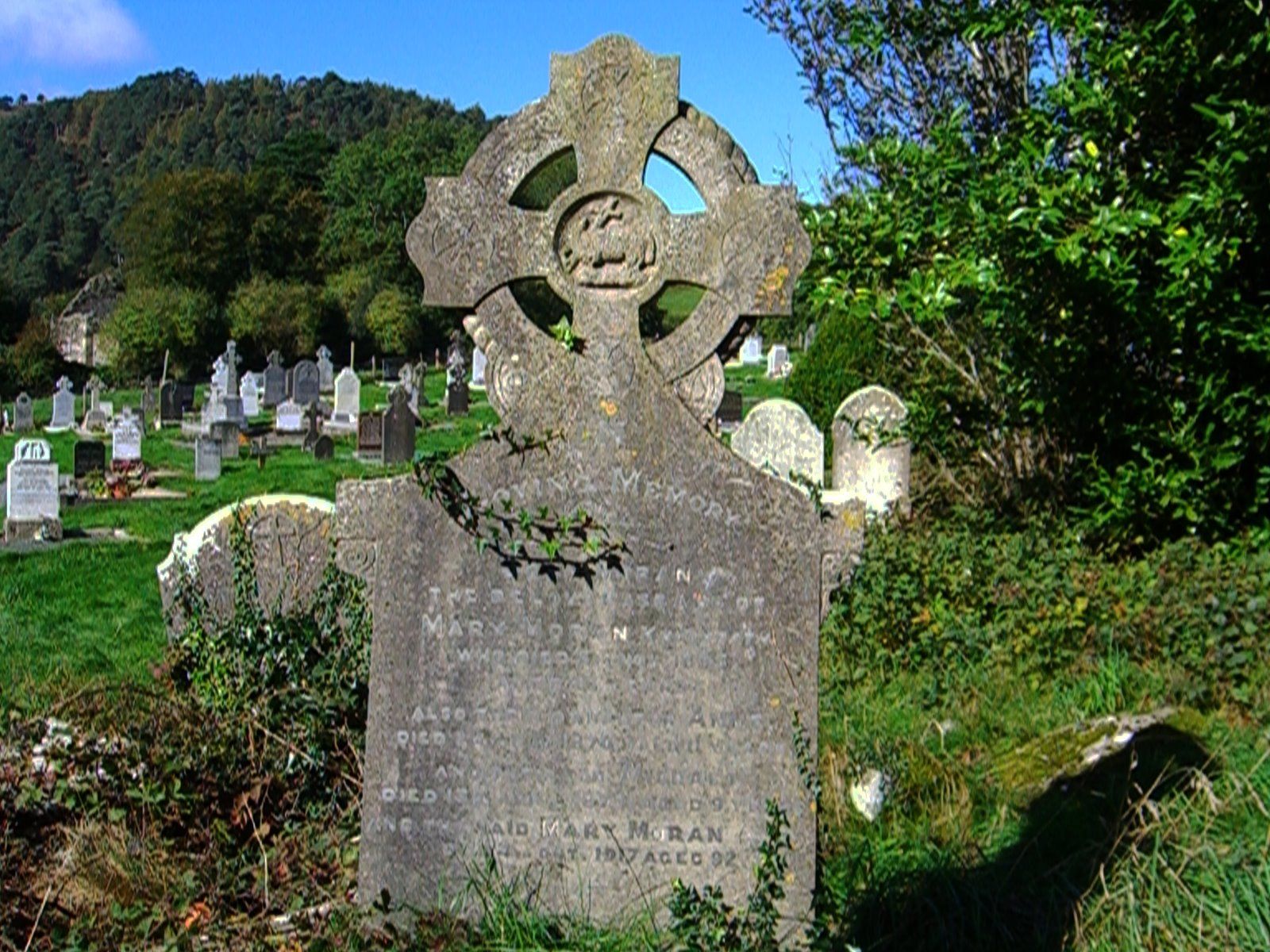
Gravestones - Glendalough
As we moved through the graveyard, we came upon the most famous of all the landmarks in the area, which is the Round Tower. This is one of the most well-preserved Round towers in Ireland and stands one hundred and ten feet above the ground. It was constructed over one thousand years ago by the monks of St. Kevin's monastery. Apparently, the roof was replaced in 1876 after it was struck by lightning. It is said by the locals that a man by the name of Sam Kennedy danced around the rim of the tower each day while the repairs were being made. The tower, which was originally built to be a bell tower, was used as a place of refuge when the monastery was attacked by Viking marauders, as most Round Towers were used. We were fortunate to have a group of crows fly out of the tower just as I captured an image. Tom was manning the camcorder, and I had the Casio digital camera. The sky provided such a fantastic blue background for the image of the beautiful tower.
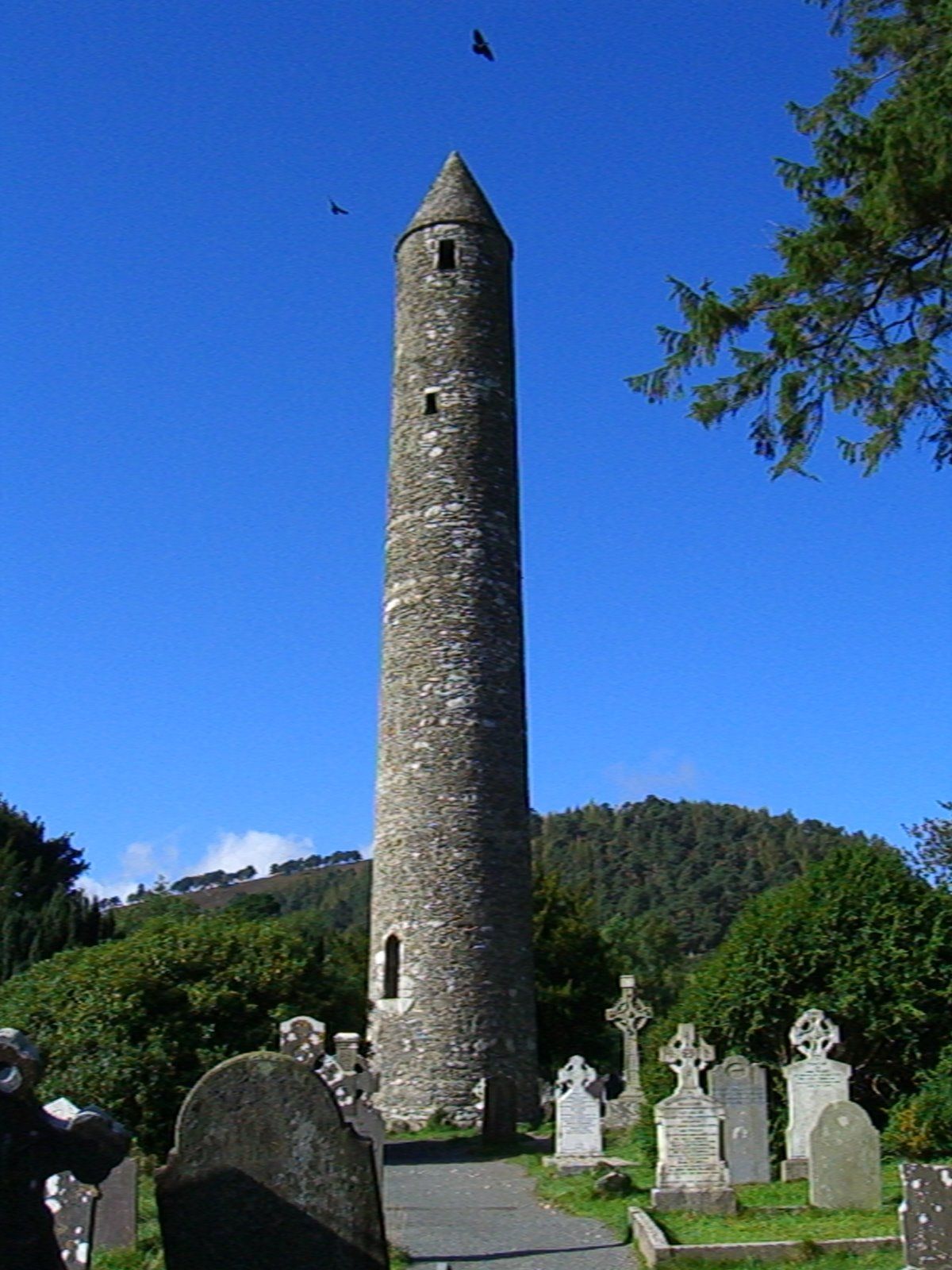
Crows Above Round Tower - Glendalough
The entire compound is filled with magnificent headstones and crosses. The buildings are also equally impressive. One, in particular, caught our attention. This building is known as the Cathedral. The interior walls are lined with grave slabs/markers that are memorials to the many monks who lived and worked at Glendalough through the centuries. There are even slabs on the ground. The Cathedral itself went through several phases of construction. The mica-schist stones which are above the west doorway were originally used in one of the smaller churches on the grounds. The design very much reminded us of the stonework on some of the buildings at Old Mellifont Abby, which we had visited in October 2005.
The sacristy and chancel date from the late twelfth and early thirteenth centuries, with the chancel itself beautifully decorated with stonework. There is a piscina, which was a basin used for washing sacred vessels, and a wall cupboard, which was used for storage of these same vessels. There is so much to see at Glendalough, but our day was barely started, and we knew that we would have to leave soon. We wandered around a bit more, taking more pictures and videos. Saint Kevin had certainly picked a beautiful site to begin the life of a hermit, even though his plan didn't actually pan out.
The Book of Glendalough, in Gaelic the Lebor Glinne Dá Loch, is a manuscript written and compiled here at this site between 1125 CE and 1130 CE. The book had at one time been confused with the Book of Leinster, in Gaelic the Lebhar Na Núachongbála. The Book of Glendalough contains the Senchas na Laignech, which is a collection of historical texts from a Leinster point of view, and the Saltair na Rann, or Psalter of Verses, a narrative poem of one hundred and sixty-two cantos which describe the story of creation, some Old Testament history, the life of Jesus, and the Final Judgement. This book now resides at the Bodleian Library, Oxford, England.
*Originally published January 2023. Updated in July 2023.
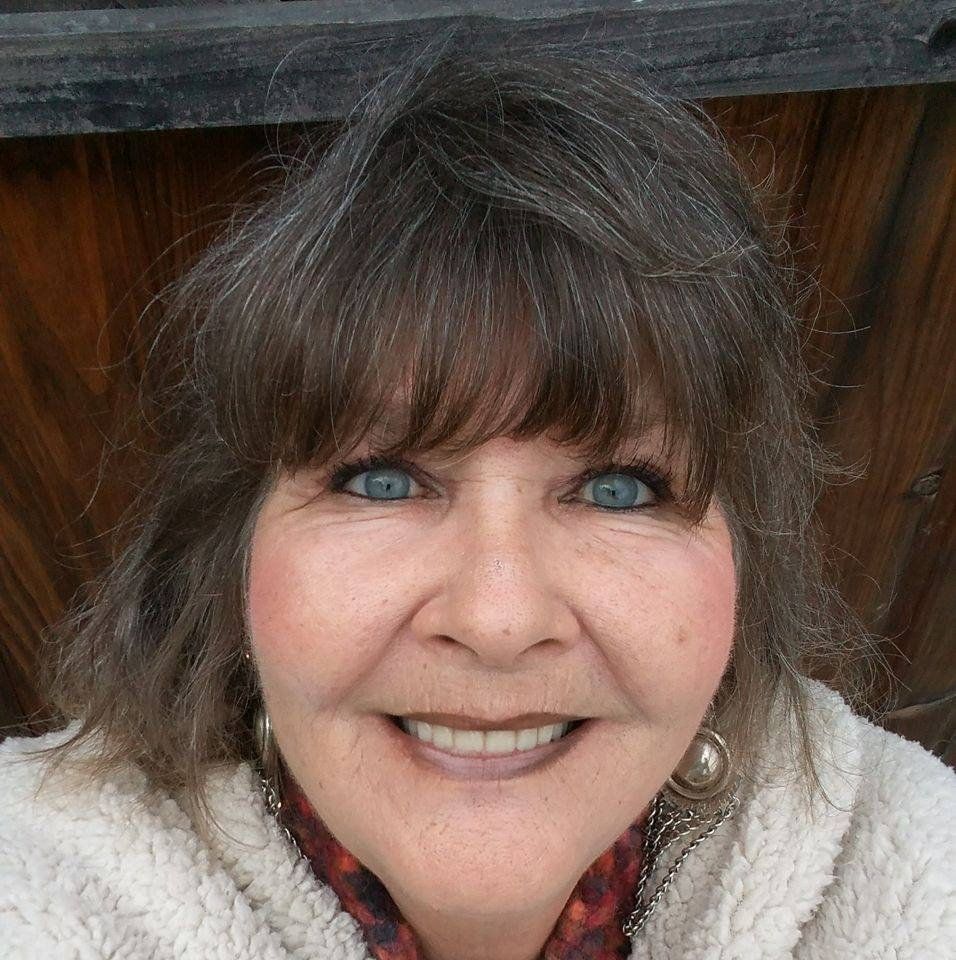
Susan Isabella Sheehan is a published author with four books to her credit, including "Ireland Journey - September 2008: A Retrospective."
This article was submitted to the IrishCentral contributors network by a member of the global Irish community. To become an IrishCentral contributor click here.



Comments